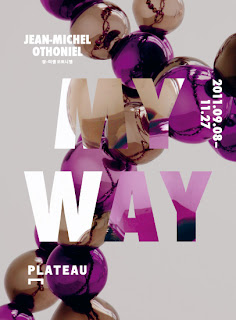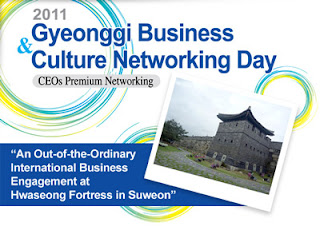 A perfect weather, a friendly atmosphere, a lively game with five goals... total success for this second edition of the FC Seoul's Expats Day !
A perfect weather, a friendly atmosphere, a lively game with five goals... total success for this second edition of the FC Seoul's Expats Day !Thousands of expats were invited by the club, Seoul Global Center, and 10 Magazine for an afternoon of animation and a K-League clash between FC Seoul and Daejeon Citizens at the Seoul World Cup Stadium (a very special place for me : I attended its inaugural game, the 2002 FIFA World Cup opener - a stunning but well deserved victory of Senegal over France -, or the last confrontation between ROK and PRK) :
 Gathering all communities for a festive moment, there's no better way of promoting the club, the league, and the game. The club hosted the event wonderfully, from the organizers backstage to the fans in the tribunes to the players on the field.
Gathering all communities for a festive moment, there's no better way of promoting the club, the league, and the game. The club hosted the event wonderfully, from the organizers backstage to the fans in the tribunes to the players on the field.Beyond Seoul's own trio of Expats Dejan Damjanovic (three goals for the Montenegrin), Adilson (impressive coverage by the Brazilian), and Mauricio Molina (even in a mediocre day, the Columbian managed to score the final goal), the whole team delivered a very convincing game, leveraging on a strong defense, a swift midfield, and diversified attacks. Daejeon players too felt in a giving mood, offering a few gifts, starting only a few minutes after the kick off with an assist to Damjanovic for his first goal. Park Sung-ho could have played a bit faster to bring more danger, but the Citizens never gave up. Even a little tension at the end of the game didn't spoil the mood : the referee promptly exposed a few cards matching his yellow jersey, and after all, the game itself was not supposed to be friendly.
4-1. This glorious day brings FC Seoul closer to the play-offs (preferably with a ticket for next AFC Champions League - and another K-League title ?), and to a more than ever international audience.
Seoul Village 2011
NEW : follow Seoul Village on Facebook and Twitter
PS : thanks to Korea4Expats for the tickets !

 These guys defying gravity look like they could be the next customers of the building they're cleaning.
These guys defying gravity look like they could be the next customers of the building they're cleaning. Over 4,000 representations of the rock musical "Line 1" were given between 1994 and 2008 in Daehangno's Hakchon Theater.
Over 4,000 representations of the rock musical "Line 1" were given between 1994 and 2008 in Daehangno's Hakchon Theater. Donated Collection of Rock Musical 'Line 1'
Donated Collection of Rock Musical 'Line 1' But the jewel of the crown is the Korean Street Food / Korean Food Street : a whole village full of life and terrific food. If the National Folk Museum of Korea were to propose a live show of Korean specialities, that would be it. The full course at Byeokgyesu costs only KRW 11,000 for lunch, and KRW 17,000 for dinner. It may look classic from a distance, but every single banchan has a unique story to tell and an incredible taste to reveal.
But the jewel of the crown is the Korean Street Food / Korean Food Street : a whole village full of life and terrific food. If the National Folk Museum of Korea were to propose a live show of Korean specialities, that would be it. The full course at Byeokgyesu costs only KRW 11,000 for lunch, and KRW 17,000 for dinner. It may look classic from a distance, but every single banchan has a unique story to tell and an incredible taste to reveal. It had to happen.
It had to happen. Strange feeling, yesterday, as I roamed the inaugural exhibitions at the brand new old Seoul Station ("Countdown" and YIPPA 2011 - see "
Strange feeling, yesterday, as I roamed the inaugural exhibitions at the brand new old Seoul Station ("Countdown" and YIPPA 2011 - see " We started with the Yonhap photo expo, which certainly didn't lift our moods : UN Millennium Development Goals are about tackling every dimensions of human misery, and in "Share the Moment, Share the Future", photographers from all horizons are precisely pointing their fingers where it hurts. Tough images, utter despair, with just the occasional glimmer of hope...
We started with the Yonhap photo expo, which certainly didn't lift our moods : UN Millennium Development Goals are about tackling every dimensions of human misery, and in "Share the Moment, Share the Future", photographers from all horizons are precisely pointing their fingers where it hurts. Tough images, utter despair, with just the occasional glimmer of hope... Imperfections are welcome, even if the green wooden windows didn't have to be that respectful of the old days : as you can see on this picture (sorry for the quality, I'm all thumbs with picturephones), they are not weatherproof.
Imperfections are welcome, even if the green wooden windows didn't have to be that respectful of the old days : as you can see on this picture (sorry for the quality, I'm all thumbs with picturephones), they are not weatherproof. What a cultural year for France in Korea ! We've seen French musea send key works to Seoul and Daejeon (respectively Musee d'Orsay and Musee d'Art Moderne de Saint-Etienne*), the nation return Oegyujanggak books to their homeland**, and now our top private collector display some of his goods to the Korean public.
What a cultural year for France in Korea ! We've seen French musea send key works to Seoul and Daejeon (respectively Musee d'Orsay and Musee d'Art Moderne de Saint-Etienne*), the nation return Oegyujanggak books to their homeland**, and now our top private collector display some of his goods to the Korean public. You want more contemporary art from France ? 80 Jean-Michel Othoniel works will be exhibited at galerie Plateau starting this Thursday. First of its kind, this comprehensive retrospective is also organized by Centre Pompidou, with the benediction of The Institut Francais de Coree du Sud, another eminent resident of this Sungnyemun neighborhood (OK, the IFC is comfy, the Cafe des Arts yummy, and Sungnyemun about to reopen as a fantastic landmark, but I surely miss the old Centre Culturel Francais next to Gyeongbokgung !).
You want more contemporary art from France ? 80 Jean-Michel Othoniel works will be exhibited at galerie Plateau starting this Thursday. First of its kind, this comprehensive retrospective is also organized by Centre Pompidou, with the benediction of The Institut Francais de Coree du Sud, another eminent resident of this Sungnyemun neighborhood (OK, the IFC is comfy, the Cafe des Arts yummy, and Sungnyemun about to reopen as a fantastic landmark, but I surely miss the old Centre Culturel Francais next to Gyeongbokgung !). 
 Following the success of Seoul Global Business Support Center networking events*, KBC (Korea Business Central) organizes with Gyeonggi Province, and the GAFIC (Gyeonggi Association of Foreign Invested Companies) the first Gyeonggi Business & Culture Networking Day.
Following the success of Seoul Global Business Support Center networking events*, KBC (Korea Business Central) organizes with Gyeonggi Province, and the GAFIC (Gyeonggi Association of Foreign Invested Companies) the first Gyeonggi Business & Culture Networking Day.



